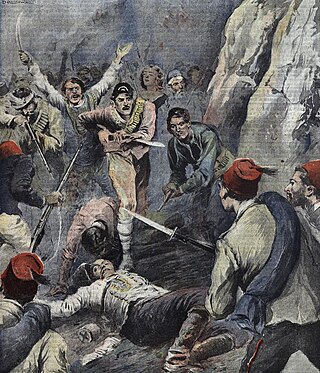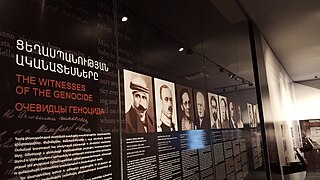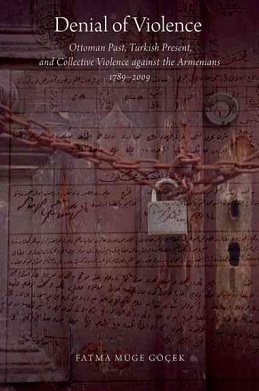
The Armenian genocide was the systematic destruction of the Armenian people and identity in the Ottoman Empire during World War I. Spearheaded by the ruling Committee of Union and Progress (CUP), it was implemented primarily through the mass murder of around one million Armenians during death marches to the Syrian Desert and the forced Islamization of others, primarily women and children.

The Hamidian massacres also called the Armenian massacres, were massacres of Armenians in the Ottoman Empire in the mid-1890s. Estimated casualties ranged from 100,000 to 300,000, resulting in 50,000 orphaned children. The massacres are named after Sultan Abdul Hamid II, who, in his efforts to maintain the imperial domain of the declining Ottoman Empire, reasserted pan-Islamism as a state ideology. Although the massacres were aimed mainly at the Armenians, in some cases they turned into indiscriminate anti-Christian pogroms, including the Diyarbekir massacres, where, at least according to one contemporary source, up to 25,000 Assyrians were also killed.

Armenian Genocide Remembrance Day or Armenian Genocide Memorial Day is a public holiday in Armenia and the Republic of Artsakh and is observed by the Armenian diaspora on 24 April. It is held annually to commemorate the victims of the Armenian genocide of 1915. It was a series of massacres and starvation of 1.5 million Armenians by the Ottomans. In Yerevan, the capital of Armenia, hundreds of thousands of people walk to the Tsitsernakaberd Genocide Memorial to lay flowers at the eternal flame.
Justin A. McCarthy is an American demographer, former professor of history at the University of Louisville, in Louisville, Kentucky. He holds an honorary doctorate from Boğaziçi University (Turkey), was awarded the Order of Merit of Turkey, and is a board member of the Institute of Turkish Studies and the Center for Eurasian Studies (AVIM). His area of expertise is the history of the late Ottoman Empire.

Armenian genocide denial is the claim that the Ottoman Empire and its ruling party, the Committee of Union and Progress (CUP), did not commit genocide against its Armenian citizens during World War I—a crime documented in a large body of evidence and affirmed by the vast majority of scholars. The perpetrators denied the genocide as they carried it out, claiming that Armenians in the Ottoman Empire were resettled for military reasons, not exterminated. In the genocide's aftermath, incriminating documents were systematically destroyed, and denial has been the policy of every government of the Republic of Turkey, as of 2023, and later adopted by the Republic of Azerbaijan, as of 1991.
The Battle of Dilman was a battle during World War I fought at Dilman between the Russian Empire and the Ottoman Empire.
Donald Bloxham FRHistS is a Professor of Modern History, specialising in genocide, war crimes and other mass atrocities studies. He is the editor of the Journal of Holocaust Education.

Marquess Johann von Pallavicini was an Austro-Hungarian nobleman and diplomat, notably serving as ambassador at the Sublime Porte during World War I.

The Albanian revolt of 1910 was a reaction to the new centralization policies of the Young Turk Ottoman government in Albania. It was the first of a series of major uprisings. Rebels were supported by the Kingdom of Serbia. New taxes levied in the early months of 1910 led to Isa Boletini's activity to convince Albanian leaders who had already been involved in a 1909 uprising to try another revolt against the Ottoman Empire. The Albanian attacks on the Ottomans in Priştine and Ferizovik, the killing of the Ottoman commander in İpek, and the insurgents' blocking of the railway to Skopje at the Kaçanik Pass led to the Ottoman government's declaration of martial law in the area.
Donald George Quataert was a historian at Binghamton University. He taught courses on Middle East/Ottoman history, with an interest in labor, social and economics, during the early and modern periods. He also provided training in the reading of Ottoman archival sources.

Witnesses and testimony provide an important and valuable insight into the events which occurred both during and after the Armenian genocide. The Armenian genocide was prepared and carried out by the Ottoman government in 1915 as well as in the following years. As a result of the genocide, as many as 1.5 million Armenians who were living in their ancestral homeland were deported and murdered.
Ethnic nationalism, also known as ethnonationalism, is a form of nationalism wherein the nation and nationality are defined in terms of ethnicity, with emphasis on an ethnocentric approach to various political issues related to national affirmation of a particular ethnic group.
The Armenian Massacres in Ottoman Turkey: A Disputed Genocide is a 2006 book by Guenter Lewy about the Armenian genocide in the Ottoman Empire. In the book, Lewy argues that the high death toll among Ottoman Armenians was a byproduct of the conditions of the marches and on sporadic attacks rather than a planned attempt to exterminate them.
Bibliography of the Armenian genocide is a list of books about the Armenian genocide:

Denial of Violence: Ottoman Past, Turkish Present and Collective Violence Against the Armenians, 1789–2009 is a 2015 book by Turkish sociologist Fatma Müge Göçek which deals with the denial, justification, and rationalization of state-sponsored violence against Armenians in the Ottoman Empire and Turkey from the eighteenth to the twenty-first century, focusing especially on the Armenian genocide and its persistent denial in Turkey. Among the arguments made in the book is that the Armenian genocide was an act of foundational violence that enabled the creation of the Republic of Turkey and its continuing denial is an ideological foundation of the Turkish nation-state. The book was praised by reviewers for its extensive research and methodological innovation, although some noted that it was dense and not easy to read for those not familiar with the topic.

Open Wounds: Armenians, Turks and a Century of Genocide is a 2015 book by Vicken Cheterian and published by Hurst that aims to be a "political history of the genocide since [1915] and the consequences of denialism". The book was praised for its comprehensiveness and accessibility to a wide audience.
National economy is the economic plan, essentially kleptocratic, envisioned by Ziya Gökalp and carried out by successive Ottoman and Turkish governments, which involved the systematic dispossession of native Christian upper-classes and their replacement by Muslim Turks, in addition to large-scale confiscation and redistribution of Christian-owned property. Türk Yurdu announced 1915 as the starting year of the national economy. To Emil Ludwig, Talaat Pasha mentioned that the loss of the Armenian workforce would damage the economy for a short while, but that Turks would step in their positions and replace the Armenians soon.

Differing views of what caused the Armenian genocide include explanations focusing on nationalism, religion, and wartime radicalization and continue to be debated among scholars. In the twenty-first century, focus has shifted to multicausal explanations. Most historians agree that the genocide was not premeditated before World War I, but the role of contingency, ideology, and long-term structural factors in causing the genocide continues to be discussed.
The Battle of Carraleva Pass was a battle between Albanian rebels and Ottoman forces during the Revolt of 1910. The clash represented a military offensive launched by Shevket Turgut Pasha against Albanian rebels that were blocking the Carraleva Pass. After 3 Days of fighting the Albanian insurgents were defeated and retreated to the Drenica region.
The Battle of Agri Pass was a battle between Albanian rebels and Ottoman forces during the Revolt of 1910. The clash represented a military offensive launched by Shevket Turgut Pasha against Albanian rebels that were blocking the Agri Pass in the Bajrak of Nikaj-Mërtur. The Ottomans were defeated.











